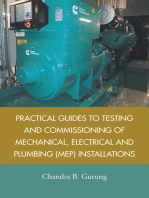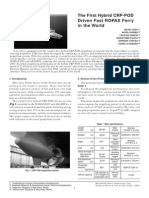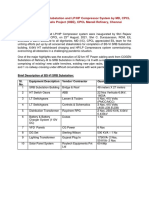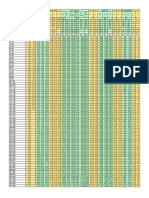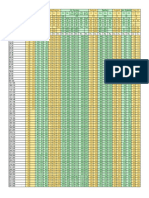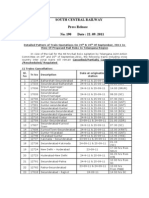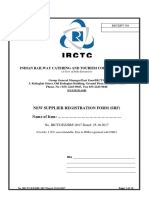Vocational Training Project On HHP Loco Alternator: Diesel Loco Shed West Central Railway, Itarsi Madhya Pradesh
Vocational Training Project On HHP Loco Alternator: Diesel Loco Shed West Central Railway, Itarsi Madhya Pradesh
Uploaded by
Kundan BhartiCopyright:
Available Formats
Vocational Training Project On HHP Loco Alternator: Diesel Loco Shed West Central Railway, Itarsi Madhya Pradesh
Vocational Training Project On HHP Loco Alternator: Diesel Loco Shed West Central Railway, Itarsi Madhya Pradesh
Uploaded by
Kundan BhartiOriginal Title
Copyright
Available Formats
Share this document
Did you find this document useful?
Is this content inappropriate?
Copyright:
Available Formats
Vocational Training Project On HHP Loco Alternator: Diesel Loco Shed West Central Railway, Itarsi Madhya Pradesh
Vocational Training Project On HHP Loco Alternator: Diesel Loco Shed West Central Railway, Itarsi Madhya Pradesh
Uploaded by
Kundan BhartiCopyright:
Available Formats
DIESEL LOCO SHED
WEST CENTRAL RAILWAY, ITARSI
MADHYA PRADESH
VOCATIONAL TRAINING PROJECT
On
HHP LOCO ALTERNATOR
(18/07/2022-30/07/2022)
SUBMITTED TO: - S.K. GUPTA Sir Submitted by- Deepesh Chief
Loco Inspector (Training) Enrol.no.-20018M01018 Diesel loco
shed Itarsi (M.P.)
ELECTRICAL ENGINEERING
GOVT. POLYTECHNIC COLLEGE,
HARDA (M.P.)
GOVT. POLYTECHNIC COLLEGE, HARDA(M.P)
DECLARATION
I am Deepesh, hereby declare that this project is being
submitted in fulfillment of the Industrial Training Program
in DIESEL LOCOSHED ITARSI (M.P.), and is result of self done
work carried out by me under the various guidance of
engineers and other officers.
I further declare that to my knowledge, the structure and
content of this projected are original and have not been
submitted before for any purpose.
Deepesh
Diploma 2nd year(4th sem)
Electrical Engineering
Harda (M.P.)
HHP LOCO ALTERNATOR Page 2
GOVT. POLYTECHNIC COLLEGE, HARDA(M.P)
ACKNOWLEDGEMENT
We are using the opportunity to express my gratitude to everyone
who supported me throughout this training. I am thankful for their
aspiring guidance, invaluable constructive criticism and friendly
advice during project work. I am sincerely grateful to them for
sharing their truthful and illuminating view on a number of issues
related to this project.
I express my warm thanks to Mr. S.K. GUPTA for his support and
guidance Diesel Loco Shed.
Thanking You
HHP LOCO ALTERNATOR Page 3
GOVT. POLYTECHNIC COLLEGE, HARDA(M.P)
Content
1. About Indian Railways.
2. History of Diesel Loco Shed.
3. Various Sections in Diesel Loco Shed.
4. Project on “AIR BRAKE SYSTEM”(CCB-2)
a) General Description
b) Component Description
c) System Back-ups
d) Modes of Operation of CCB-II
e) Operating Pressure
f) Additional Features
g) Diagnostic
h) Procedure of Air brake self test
i) Advantages of CCB
j) DOs and DON’Ts
k) Abbreviations
HHP LOCO ALTERNATOR Page 4
GOVT. POLYTECHNIC COLLEGE, HARDA(M.P)
INDIAN RAILWAYS
Indian railway is the one of the most important organization of India. It is headed by
Ministry of Railway, assisted by Railway Board which is headed by chairman railway
head.
Indian Railway has the largest rail network in Asia and the world's second largest
under one management, transporting 1.33 crore passenger and about 1.3 million
tonnes goods daily. It is one of the world's largest commercial or utility employers,
with more than 13 lac employee.
The railways transverse the length and breadth of the country, covering 6855
passenger station with huge infrastructure including 120000 bridges, which stand
2nd in the world.
Railways were first introduced to India in 1853 by 1947, there were 42 rail systems. In
1951 the systems were nationalized as one unit, becoming one of the largest
networks in the world, IR operates both long distance and sub urban rail systems on
multi gauge network of broad, meter and narrow gauges.
It also owns locomotives and coach production facilities initially; the Indian railways
were both designed and built by the British, during their colonial rule of the
subcontinent.
Indian Railways was started on 16.04.1953 with steam engines having 14 coaches
from Porbander to thane, then in Calcutta on 15.08.1854.
Brief History of Diesel LocoShed,
Itarsi
Diesel Loco Shed Itarsi was established in 1964 in Bhopal
division of west central. It is now rated as one of the premier
shed of Indian Railways. The Diesel Loco Shed is now homing
WDM-2, WDM-3A, WDM-3D and WDS-6 class of Diesel
HHP LOCO ALTERNATOR Page 5
GOVT. POLYTECHNIC COLLEGE, HARDA(M.P)
Locomotives. The existing holding of the Shed is 171 locos,
with a mail link of 97 Locos and goods outage target of 35
Locos. Now shed is ready to take the challenge of homing
WDP-4 (4000&4500HP Locos) GM locos. A fullyfledged
Chemical & Metallurgical Laboratory has been established in
this shed. Two Effluent Treatment Plant & Incinerator are also
available. A Diesel Technical Training Centre for training the
supervisors, artisans and operating/running staff is also
functional in the Shed.
MAINTENANCE SHED
HHP LOCO ALTERNATOR Page 6
GOVT. POLYTECHNIC COLLEGE, HARDA(M.P)
Project
On
Air Brake System
(CCB-2)
HHP LOCO ALTERNATOR Page 7
GOVT. POLYTECHNIC COLLEGE, HARDA(M.P)
DESCRIPTION OF THE CCB-2 BRAKE SYSTEM
a) General description -
CCB II-IR is a microprocessor based electro-pneumatic brake control system. A CCB II-IR
equipped locomotive can LEAD or Trail a multiple unit consist and can be operated as a Helper
unit. CCB II-IR is comprised of distributed electronics for improved reliability, serviceability and
failure analysis. CCB II-IR includes modular LRU’s for ease oftrouble shooting & repairs.
b) Component Description – The main components are as following :
HHP LOCO ALTERNATOR Page 8
GOVT. POLYTECHNIC COLLEGE, HARDA(M.P)
1) EPCU: Electro-Pneumatic Control Unit –
The EPCU consists of 9 LRU’s-
I. ERCP - Equalizing Reservoir Control Portion
II. BPCP - Brake Pipe Control Portion
III. 16CP - 16 Pipe Control Portion
IV. BCCP – Brake Cylinder Control Portion
V. 20CP - 20 Pipe Control Portion
VI. KE – KE Valve
VII. PSJB – Power supply Junction Box
VIII. RCP – Relay Control Portion
IX. LON-485 Converter
HHP LOCO ALTERNATOR Page 9
GOVT. POLYTECHNIC COLLEGE, HARDA(M.P)
EPCU: Electro-Pneumatic Control Unit
2) EBV- Electronic Brake Valve-
HHP LOCO ALTERNATOR Page 10
GOVT. POLYTECHNIC COLLEGE, HARDA(M.P)
The EBV is the “Man Machine” interface to the CCB II-IR Brake System. The EBV communicatesER and BCEP
commands (handle movements) by the driver to the Air Brake System via the
LON network.EBV communicates via an intelligent ‘Node’. The EBV is designed for installationas a
desktop mount. It is used by the Engineer to control the Independent Brake, Automatic Brake and Bail-
off.
The EBV includes a “Target Display” that allows the Engineer to know, immediately, how much
reduction is requested when the handle is moved. Faults are annunciated to the operator via anLCD
screen mounted on the Driver’s Brake Valve (EBV). This screen is also used for routine advisory
instructions such as penalty reset and emergency reset.Selector switch on EBV has four positions
i.e.Lead,Trial,Helper,Test modes.
3)Dead Engine Regulator (DER) –
DER COC Dead Engine Cut-In / Cut-out Cock.
– Out - Closes Brake Pipe connection to Dead Engine Regulator.
– IN - Opens BP connection to Dead engine Regulator so Main Reservoir can be charged fromBP.
DER
Dead Engine Regulator
– Reduces Brake Pipe Pressure to Main Reservoir / Dead Engine Pressure
– The DER is necessary in order for a locomotive that is being towed dead in train to be able toapply
brake cylinder as Brake Cylinder is charged from MR
4) KE Valve-
• Allows for pneumatic function in the case of electronics failure
• Incorporates a ‘Passenger / Goods’ selection lever
• The second lever is for isolation of the valve for maintenance
HHP LOCO ALTERNATOR Page 11
GOVT. POLYTECHNIC COLLEGE, HARDA(M.P)
5) Pneumatic ER Back Up (PER) Changeover Cock: - Allows use of
pneumatic driver’s backup brake valve in case of critical failure.
6) Direct Brake Handle:-
The Direct Brake Handle has two positions namely ‘Release’ and ‘FULL’.
Automatic brake Handle: - Automatic brake Handle has five positions i.e. Release position
,Run position, Minimum reduction brake application, Full service application, Emergency
application position.
c) System Back-ups:-
.
Brake Cylinder Back-up – If the computer controlled BC pilot controller (16CP) fails,the
system will automatically switch over to using the KE valve output for BC pilot.
Independent Handle Back-up – If the BCE pipe controller (20CP) fails, the system will
automatically switch to a back-up mode wherein the 16CP develops locomotive brake cylinder
pressure in response to the independent handle.
HHP LOCO ALTERNATOR Page 12
GOVT. POLYTECHNIC COLLEGE, HARDA(M.P)
Pneumatic ER Back-up (Optional) – The system is provisioned to optionally allow use of aback-up
pneumatic ER controller and switchover cock.
d) Modes of Operation of CCB II:- There are six modes of operation for the
CCB II-IR system. They are:
LEAD CUT-IN or SINGLE UNIT - Independent brake control is available via the (EBV) Independent handle.
Equalizing reservoir (ER) control is available via the EBV Automatichandle. The brake pipe pressure is
‘Cut-In’ and follows equalizing reservoir pressure increasing and decreasing.
HELPER (LEAD CUT-OUT) - Independent brake control is available via the EBV Independent handle.
Automatic brake control remains inactive. Emergency brake is alwaysavailable via the AUTO handle.:
TEST – Auto BP is cut out, ER follows the EBV Automatic handle, and Direct BC will buildto 5.4 Kg/cm2
automatically. This position is used for testing the BP leakage of the train.
TRAIL CUT-OUT - Equalizing reservoir is exhausted and BP is ‘Cut-Out’ and is not controlled by
equalizing reservoir pressure. Brakes will apply & release in response to BPpressure and BCE pipe
depending on configuration. The EBV will not respond to handle movement except to create an
emergency application when the Auto handle is moved to ‘EMER’. Automatic brakes apply and release
in response to trainline brake pipe pressurereductions and increases.
DEAD-IN-TRAIN - The EAB system is unpowered and the locomotive is being towed in atrain (away
from a controlling consist). Brakes will apply same as a freight car.
DEAD-IN-CONSIST - The EAB system is unpowered and the locomotive is within the controlling consisting. Brakes
will apply same as a freight car from LEAD Automatic Brake.Brakes will apply same as a locomotive from LEAD
Independent Brake.
HHP LOCO ALTERNATOR Page 13
GOVT. POLYTECHNIC COLLEGE, HARDA(M.P)
e) Operating Pressure -HHP LOCO –
EBV Handles
Positions ER Kg/cm² BP Kg/cm² BCEP Kg/cm² BC Kg/cm²
Automatic
brake
Release 5.7±.07 5.7±.07 0 0
Run 5.2±.07 5.2±.07 0 0
Min 0.4 reduction 0.4 reduction 0.4±.14 0.4±.14
FS 1.5 reduction 1.5 reduction 1.8±.14 1.8±.14
EMER 0 <1.4 1.8±.14 1.8±.14
Independent
Brake
Release n/a n/a 0 0
FS n/a n/a 5.2±.14 5.2±.14
Other Pressures-
• Dead Engine Regulator 1.8±0.1 Kg/cm²
• Main Reservoir- 8 to 10 Kg/cm²
HHP LOCO ALTERNATOR Page 14
GOVT. POLYTECHNIC COLLEGE, HARDA(M.P)
Operating Pressure -Alco Locomotive-
Other Pressures –
• Dead Engine Regulator 1.8±0.1 Kg/cm²
• Main Reservoir - 8 to 10 Kg/cm²
f) Additional Features:
Includes Real Time Clock in EBV
“Smart” LRUs include logs
Includes crew advisory on EBV display
Fully potted electronic modules.
HHP LOCO ALTERNATOR Page 15
GOVT. POLYTECHNIC COLLEGE, HARDA(M.P)
HHP LOCO ALTERNATOR Page 16
GOVT. POLYTECHNIC COLLEGE, HARDA(M.P)
Additional safety devices can be piped to EPCU pipe 3 or 10 without SW/HW changeCan be used with
Backup DBVs, to avoid line blockage in situation of CCB failures.
g) DIAGNOSTIC:
•Self test –A routine comprehensive health test
•Fault-–Monitor braking system defects.
–Penalty brake application if critical brake fault is detected.
–Otherwise, information is displayed to the operator and send to main lococomputer
–Identify the probable device which caused the fault
•Portable test unit-
–A connection provided for portable test unit (Laptop computer) –Allows
detailed circuit and component tests for maintenance
h) PROCEDURE FOR AIR BRAKE SELF TEST:
Before running the self test verify the following safety points.
Locomotive speed is zero.
Apply hand brakes and place the skids in position.
Verify one controller is in lead and the other controller is in trail. Neitherof
the Automatic brake (A9) handle of the controllers should be in EMERGENCY
position.
Reverser to be CENTERED and throttle to be in IDLE position.
Main reservoir (MR2) pressure is above 8 Kg/sq cm.
No controller faults(20-2D & 30-3D), Passenger Goods Switch Failure
faults(4A,4B) and transducer fault(50) are active.
Do not use BAIL OFF during the self test.
Conduct the self test.
Verify self test passes. If fails consult the Diesel shed and follow the
instructions.
HHP LOCO ALTERNATOR Page 17
GOVT. POLYTECHNIC COLLEGE, HARDA(M.P)
i) ADVANTAGES OF CCB
Fault Diagnostic:
An excellent trouble shooting tool which reduces down
time of locomotive
Reduces technical skill required for trouble shooting
Self test – Reduces brake system checking time
Vigilance control trough software with no additional valve
Precise control of brake pipe and brake cylinder pressureby
electronic logic replacing pneumatic logic
Provides flexibility for future system upgrades
Enhanced safety through constant monitoring of critical
safety functions
Elimination of air pipes
HHP LOCO ALTERNATOR Page 18
GOVT. POLYTECHNIC COLLEGE, HARDA(M.P)
HHP LOCO ALTERNATOR Page 19
GOVT. POLYTECHNIC COLLEGE, HARDA(M.P)
j) DOs and DON’Ts –
DO’s :
• Lead/Trail switch on EBV is with ROTATE mechanism and always follow
this practice to rotate switch by using the knob.
• Give some time during two self tests (at least 4-5 minutes).
• Ensure Loco is isolated, Application of Handbrake, & Wheel skids are provided
before performing Air Brake self test.
• Ensure availability of sufficient MR pressure (always more than 8 Kg/cm2) before
starting self test.
• Before attaching locomotive to formation, please blow the air thru hoses (by
charging BP) and also please clean End connection of formation wagon/coaches.
At times it is found that small stone or plastic pieces flow back to Emergency Vent
Valve.
• Clear fault codes of Brake Valve Controllers i.e., 108 etc before HLPR operation.
• Always Keep Non Working Control Stand Auto Handle in FS position & DIR
handle in REL position.
• Drain moisture from MR1 & MR2 Reservoirs at regular intervals if Air Dryer is not
functioning.
• Keep the Dead-Engine COC(on ERCP) to normal position once the Dead Engine
movement is completed and the Locomotive is ready for working asLEAD/TRAIL
• In case Air Brake Alarm message is continuously displayed on LCC Screen with
alarm, once release BC pressure to ZERO (Ensure hand brakes applied), then,
automatically fault is cleared.
• If Air Brake self test failed, re-conduct self test, giving some time gap.
• If one EBV faults are logged and are not clearing, work from other EBV (may be
operated to clear the section till the other EBV is attended duly observing safety)
• While Auto Handle at FS position while changing LT switch position (other than
Test position selection –CCB will apply FS penalty if not followed.
• Recycle CCB Circuit Breaker to clear any faults logged. If not cleared then please
contact respective shed.
• Ensure proper working of Air Dryer and MR Drain valves
HHP LOCO ALTERNATOR Page 20
GOVT. POLYTECHNIC COLLEGE, HARDA(M.P)
DON’Ts
• In CCB-II do not switch – off LCC Circuit Breaker first without switching – offCCB
Circuit Breaker –CCB will log Fault Code 141 – Communication Failure.
• Never select both Controller Lead/Trail Switches to HLPR at any point orKeep
One in LEAD & the Other in HLPR/TEST.
• Do not Change Lead/Trail switch on running Locomotive.
• Do not Re-cycle CCB Circuit Breaker on a running locomotive.
• Do not hold bail off switch for long time. If Auto Brake are applied and if you are
moving Direct Brake Handle to REL position, please be careful to not to liftbail ring
other-wise it will result into release of Auto Brakes on Locomotive & Locomotive
may roll.
• Do not Power-up/Move as an Independent Power/Own Power when both
Brake Valve controllers are selected as TRAIL.
• Do not spill liquid like tea, coffee, water on the Brake Valve Controller
• Do not keep Non-working Auto handle beyond FS position.
HHP LOCO ALTERNATOR Page 21
GOVT. POLYTECHNIC COLLEGE, HARDA(M.P)
HHP LOCO ALTERNATOR Page 22
GOVT. POLYTECHNIC COLLEGE, HARDA(M.P)
HHP LOCO ALTERNATOR Page 23
GOVT. POLYTECHNIC COLLEGE, HARDA(M.P)
a) ABBREVIATIONS-
ABCB.................... AIR BRAKE CIRCUIT BREAKER
ALR ..................... ALARM RELAY
BO ........................ BAIL OFF
BC.................... BRAKE CYLINDER
BCCO................ BRAKE CYLINDERCUT-OUT PIPE
BP......................... BRAKE PIPE
BPCN................... BRAKE PIPE CONTROL NODE
BPCO................... BRAKE PIPE CUT-OFF VALVE
BPCP.................... BRAKE PIPE CONTROL PORTION
CN........................ CONTROL NODE
COC..................... CUT OFF COCK
COMM .................... COMMUNICATION
COS...................... CUTOFF SWITCH
EAB...................... ELECTRONIC AIR BRAKE
EBV...................... ELECTRONIC BRAKE VALVE
EMER. ...................... EMERGENCY
ER........................ EQUALIZING RESERVOIR
ERCP................... EQUALIZING RESERVOIR CONTROL
PORTION
ERCN................... EQUALIZING RESERVOIR CONTROL NODE
FV ......................... FEED VALVE
IND ............................ INDEPENDENT
LON ...................... LOCAL OPERATING NETWORK
LRU ...................... LINE REPLACEABLE UNIT
MIN .......................... MINIMUM
MR ........................ MAIN RESERVOIR
HHP LOCO ALTERNATOR Page 24
GOVT. POLYTECHNIC COLLEGE, HARDA(M.P)
MREP ...................MAIN RESERVOIR EQUALIZING PIPE
PCS....................... PNEUMATIC CUTOFF SWITCH
PSJB..................... POWER SUPPLY & JUNCTION BOX
PTU .......................PORTABLE TEST UNIT
REL ........................... RELEASE
RES ............................ RESERVOIR
REV .......................REVERSER CURRENT
16CP .....................16 PIPE CONTROL PORTION
16 RES ..................16 RESERVOIRS
20CP .....................20 PIPE CONTROL PORTION
#16 PIPE ...............BC APPLICATION PIPE (TO RELAY VALVE)
#20 PIPE............... INDEPENDENT (DIRECT) APPLICATIONAND RELEASE
PIPE (LOCO ONLY)
HHP LOCO ALTERNATOR Page 25
GOVT. POLYTECHNIC COLLEGE, HARDA(M.P)
HHP LOCO ALTERNATOR Page 26
GOVT. POLYTECHNIC COLLEGE, HARDA(M.P)
HHP LOCO ALTERNATOR Page 27
GOVT. POLYTECHNIC COLLEGE, HARDA(M.P)
HHP LOCO ALTERNATOR Page 28
GOVT. POLYTECHNIC COLLEGE, HARDA(M.P)
HHP LOCO ALTERNATOR
Page 29
You might also like
- Practical Guides to Testing and Commissioning of Mechanical, Electrical and Plumbing (Mep) InstallationsFrom EverandPractical Guides to Testing and Commissioning of Mechanical, Electrical and Plumbing (Mep) InstallationsRating: 4 out of 5 stars4/5 (4)
- Handbook On WDP4D (Dual Cab Loco)Document80 pagesHandbook On WDP4D (Dual Cab Loco)Rah Mli80% (5)
- Dependence On Indian RailwaysDocument20 pagesDependence On Indian RailwaysPrisha SharmaNo ratings yet
- Private Freight Terminal DetailsDocument4 pagesPrivate Freight Terminal DetailsSandeepKumarJenaNo ratings yet
- Summer Internship Report Abhishek 06Document63 pagesSummer Internship Report Abhishek 06Amber GuptaNo ratings yet
- Draft Handbook On Restoration by Hydraulic Re-Railing EquipmentDocument50 pagesDraft Handbook On Restoration by Hydraulic Re-Railing EquipmentRakhi LaddarNo ratings yet
- Bridge-Transported Bilateral Master-Slave Servo Manipulator System For Remote Manipulation in Spent Nuclear Fuel Processing PlantDocument23 pagesBridge-Transported Bilateral Master-Slave Servo Manipulator System For Remote Manipulation in Spent Nuclear Fuel Processing PlantPrabhakar JoshiNo ratings yet
- Semi-Active Control of A Nonlinear Quarter-Car Model of Hyperloop Capsule Vehicle With Skyhook and Mixed Skyhook-Acceleration Driven Damper ControllerDocument14 pagesSemi-Active Control of A Nonlinear Quarter-Car Model of Hyperloop Capsule Vehicle With Skyhook and Mixed Skyhook-Acceleration Driven Damper ControllerBirhan AbebawNo ratings yet
- Handbook On Upkeep of Electric Loco Trip ShedDocument47 pagesHandbook On Upkeep of Electric Loco Trip ShedIndrasen DewanganNo ratings yet
- Project Report-Dlw PrashantDocument15 pagesProject Report-Dlw PrashantPrashant Singh75% (4)
- Obotics EST IG: The IVRM Being Deployed in The Main Vessel Detail of The First Joint With Nested Bevel GearsDocument2 pagesObotics EST IG: The IVRM Being Deployed in The Main Vessel Detail of The First Joint With Nested Bevel GearsSaran CoolNo ratings yet
- RPP 2021 - Project Guidelines and Work PackagesDocument25 pagesRPP 2021 - Project Guidelines and Work PackagespintuNo ratings yet
- Diesel Locomotive Shed JodhpurDocument54 pagesDiesel Locomotive Shed JodhpurPiyush SolankiNo ratings yet
- Volltext PDFDocument14 pagesVolltext PDFTrần KhảiNo ratings yet
- PracticalDocument54 pagesPracticalPiyush SolankiNo ratings yet
- A Comparative Study of Simulation Results Between PHERB, ADVISOR and AUTONOMIE ModelsDocument11 pagesA Comparative Study of Simulation Results Between PHERB, ADVISOR and AUTONOMIE ModelsInternational Journal of Power Electronics and Drive SystemsNo ratings yet
- Revised LHB Maintenance Vol IIDocument967 pagesRevised LHB Maintenance Vol IIlalit dhurandher100% (1)
- SPE-176811-MS Multinode 8 ZonesDocument15 pagesSPE-176811-MS Multinode 8 ZonesGerman Andres GalloNo ratings yet
- LRT Aalborg DepotDocument38 pagesLRT Aalborg DepotyosNo ratings yet
- Project Segway 3 WheelDocument26 pagesProject Segway 3 WheelMohit ChetwaniNo ratings yet
- The First Hybrid CRP-POD Driven Fast ROPAX Ferry (Paper)Document5 pagesThe First Hybrid CRP-POD Driven Fast ROPAX Ferry (Paper)pal_malayNo ratings yet
- Maintenance Manual For Non AC LHB CoachesDocument511 pagesMaintenance Manual For Non AC LHB CoachesVeerala Hari Krishna92% (24)
- Executive Summary Report-K002Document22 pagesExecutive Summary Report-K002Harsh GuptaNo ratings yet
- 2577-18524-3-PBDocument16 pages2577-18524-3-PBmirkoNo ratings yet
- Certificate: Used in Diesel Locomotives, ECP, OWS, Maintainence & Testing'Document28 pagesCertificate: Used in Diesel Locomotives, ECP, OWS, Maintainence & Testing'Prasun DasNo ratings yet
- Troubleshooting Directory For LHB Type RMPU EOG AC Coach-Eng PDFDocument44 pagesTroubleshooting Directory For LHB Type RMPU EOG AC Coach-Eng PDFdivisional electrical engg100% (6)
- Troubleshooting Directory For LHB Type RMPU EOG AC Coach-Eng PDFDocument44 pagesTroubleshooting Directory For LHB Type RMPU EOG AC Coach-Eng PDFdivisional electrical engg100% (2)
- Hybrid Engine Controller: October 2010Document31 pagesHybrid Engine Controller: October 2010Krishna Kant ParamadathilNo ratings yet
- A New Hybrid Control Scheme For An Integrated Helicopter and Engine SystemDocument13 pagesA New Hybrid Control Scheme For An Integrated Helicopter and Engine SystemDr MechanicaNo ratings yet
- Rail AC Trouble ShootingDocument44 pagesRail AC Trouble ShootingSayeed HvacNo ratings yet
- Zajdziński 2018 IOP Conf. Ser. Mater. Sci. Eng. 421 022044Document12 pagesZajdziński 2018 IOP Conf. Ser. Mater. Sci. Eng. 421 022044Trần KhảiNo ratings yet
- AcknowledgementDocument69 pagesAcknowledgementer25amitNo ratings yet
- Aerospace Flywheel DevelopmentDocument22 pagesAerospace Flywheel DevelopmenthamzapalengaraNo ratings yet
- Jsy Ea Ky : Vuqla/Kku Vfhkdyi VKSJ Ekud Laxbu Y (Kuå&226 011Document67 pagesJsy Ea Ky : Vuqla/Kku Vfhkdyi VKSJ Ekud Laxbu Y (Kuå&226 011Bala RajuNo ratings yet
- Projectreport PDFDocument50 pagesProjectreport PDFD.DasNo ratings yet
- Question Bank On HHP LocosDocument76 pagesQuestion Bank On HHP LocosTikam Chauhan82% (11)
- Draft Report On Infrastructural Facilities For Maintenance of LHB Coaches in Open LineDocument54 pagesDraft Report On Infrastructural Facilities For Maintenance of LHB Coaches in Open LineManab DuttaNo ratings yet
- Indian Railways MP 0 0800 109 (Rev - 02) Oct 16Document26 pagesIndian Railways MP 0 0800 109 (Rev - 02) Oct 16AuslanderNo ratings yet
- High Speed Transport Sysytem - Hyperloop: A Seminar Report On Submitted ToDocument24 pagesHigh Speed Transport Sysytem - Hyperloop: A Seminar Report On Submitted ToPrashanth SaiNo ratings yet
- Design and Innovative Test of A Linear Induction Motor For Urban MagLev VehiclesDocument8 pagesDesign and Innovative Test of A Linear Induction Motor For Urban MagLev Vehiclesjoao_pinaNo ratings yet
- SPIC Volume 3 Part-2Document619 pagesSPIC Volume 3 Part-2aditigupta100kNo ratings yet
- Advanced Manned Launch SystemDocument12 pagesAdvanced Manned Launch SystemBigRIJoeNo ratings yet
- Distributed PowerDocument3 pagesDistributed PowertibvalNo ratings yet
- Final1 Helios Final Report Publishable SummaryDocument11 pagesFinal1 Helios Final Report Publishable SummarybisfotNo ratings yet
- 7 - Hydraulic - Prof. N KumarDocument18 pages7 - Hydraulic - Prof. N Kumarmis2022sbpNo ratings yet
- Proposed PNR Clark Phase 2 (Malolos Clark Railway) ProjectDocument12 pagesProposed PNR Clark Phase 2 (Malolos Clark Railway) ProjectChristy SanguyuNo ratings yet
- Indian Railways Diesel Locomotive Works: Technical Training CrntreDocument36 pagesIndian Railways Diesel Locomotive Works: Technical Training CrntreUtkarsh Singh100% (1)
- The Mhd-Controlled Turbojet Engine: An Alternate Powerplant For Access To SpaceDocument39 pagesThe Mhd-Controlled Turbojet Engine: An Alternate Powerplant For Access To Spacecadourian1No ratings yet
- Indication of Brake Failure by Using IR SensorDocument3 pagesIndication of Brake Failure by Using IR SensormahendranNo ratings yet
- Design and experimental verification on characteristics ofelectro-hydraulic pumpDocument24 pagesDesign and experimental verification on characteristics ofelectro-hydraulic pumpganicayNo ratings yet
- Electro HydraulicbrakeDocument22 pagesElectro HydraulicbrakeSam JacobNo ratings yet
- Railway Intership ReportDocument19 pagesRailway Intership ReportAbdulRehman0% (1)
- Disclosure To Promote The Right To InformationDocument22 pagesDisclosure To Promote The Right To InformationRajashekar.PNo ratings yet
- Multicore & SimulinkDocument6 pagesMulticore & SimulinkSalemHasnaouiNo ratings yet
- 10 Ch7 DepotDocument17 pages10 Ch7 DepotSOMU_61No ratings yet
- The Development of Hydrogen Mine Vehicle Power Plant Functions ControllersDocument7 pagesThe Development of Hydrogen Mine Vehicle Power Plant Functions ControllersDirceu NascimentoNo ratings yet
- Week 6 - Actuators For RobotsDocument9 pagesWeek 6 - Actuators For RobotsrobrebvaldezNo ratings yet
- Design and Experiments of The Active Magnetic Bearing System For The Htr-10Document16 pagesDesign and Experiments of The Active Magnetic Bearing System For The Htr-10andy131078No ratings yet
- Inauguration of SRB Substation and LP/HP Compressor System by MD, CPCL at BS-VI Auto Fuels Project (OBE), CPCL Manali Refinery, ChennaiDocument7 pagesInauguration of SRB Substation and LP/HP Compressor System by MD, CPCL at BS-VI Auto Fuels Project (OBE), CPCL Manali Refinery, ChennaiSree Arvind Harish SomasundaramNo ratings yet
- Bhel Lem ReportDocument33 pagesBhel Lem ReportHarshita GautamNo ratings yet
- Advances in Motion Sensing and Control for Robotic Applications: Selected Papers from the Symposium on Mechatronics, Robotics, and Control (SMRC’18)- CSME International Congress 2018, May 27-30, 2018 Toronto, CanadaFrom EverandAdvances in Motion Sensing and Control for Robotic Applications: Selected Papers from the Symposium on Mechatronics, Robotics, and Control (SMRC’18)- CSME International Congress 2018, May 27-30, 2018 Toronto, CanadaFarrokh Janabi-SharifiNo ratings yet
- Welcome To Indian Railway Passenger Reservation Enquiry PDFDocument2 pagesWelcome To Indian Railway Passenger Reservation Enquiry PDFRadha KrishnanNo ratings yet
- Dum Dum To Taratala Metro Route - Kolkata Metro - YoMetro 2Document1 pageDum Dum To Taratala Metro Route - Kolkata Metro - YoMetro 2Nitin KunwarNo ratings yet
- Indian Rail Fare Effective 25-Dec-2015Document34 pagesIndian Rail Fare Effective 25-Dec-2015Saptarshi ChatterjeeNo ratings yet
- Summer Internship ReportDocument36 pagesSummer Internship ReportAman ChrunguNo ratings yet
- Alp BookDocument411 pagesAlp BookIM THE GAMENo ratings yet
- RTM Module-5-2018Document70 pagesRTM Module-5-2018Himang JainNo ratings yet
- 1534165911587-Timing 2018Document158 pages1534165911587-Timing 2018Ashok Kumar BiswalNo ratings yet
- Indian Rail Fare Effective 25-Dec-2015Document34 pagesIndian Rail Fare Effective 25-Dec-2015nithansaNo ratings yet
- RAILDocument8 pagesRAILOffice LiveNo ratings yet
- Ykk Training PPT On LocomotiveDocument17 pagesYkk Training PPT On LocomotiverajendraNo ratings yet
- All Trains From VijayawadaDocument5 pagesAll Trains From Vijayawadaapi-26483995100% (2)
- Achievement of Track Design DirectorateDocument33 pagesAchievement of Track Design Directoratepriyaranjan kunwarNo ratings yet
- Cancelled TrainsDocument13 pagesCancelled TrainsNDTVNo ratings yet
- State Wise GST Number of IRCTCDocument1 pageState Wise GST Number of IRCTCStNo ratings yet
- Monopoly in IRDocument17 pagesMonopoly in IRakashNo ratings yet
- Welcome To Indian Railway Passenger Reservation EDocument1 pageWelcome To Indian Railway Passenger Reservation EVisha KhubchandniNo ratings yet
- Indian RailwaysDocument32 pagesIndian RailwaysTushar MathurNo ratings yet
- MP-MISC-326 - Report On AMC-AC-AC-Traction-Control-System-16.12.2019Document36 pagesMP-MISC-326 - Report On AMC-AC-AC-Traction-Control-System-16.12.2019LSRE KYNNo ratings yet
- TrainDocument6 pagesTrainsubhajit284No ratings yet
- Dynamic Analysis of High Speed Railway Track: PHD Research Proposal TopicDocument14 pagesDynamic Analysis of High Speed Railway Track: PHD Research Proposal TopicReenu VermaNo ratings yet
- Famous: D. Nani PalkhivalaDocument6 pagesFamous: D. Nani PalkhivalaAdrianna SilverNo ratings yet
- Indian Railway Catering and Tourism Corporation LTD.: New Supplier Registration Form (SRF) Name of ItemDocument12 pagesIndian Railway Catering and Tourism Corporation LTD.: New Supplier Registration Form (SRF) Name of Itemaman3327No ratings yet
- FinalDocument42 pagesFinalSonali JainNo ratings yet
- Indian Railways: 1 1 January, 2005 AllDocument11 pagesIndian Railways: 1 1 January, 2005 Allsourabhsdn76No ratings yet
- Industrial Training ReportDocument30 pagesIndustrial Training ReportHimanshu Rawat100% (1)
- 14C9 Pricing Strategy - Indian RailwaysDocument21 pages14C9 Pricing Strategy - Indian Railwaysprateek678100% (2)
- Challenges Faced by Indian RailwaysDocument1 pageChallenges Faced by Indian Railways001iammohitsharmaNo ratings yet
- Signal and Telecommunication Workshop-2Document13 pagesSignal and Telecommunication Workshop-2Sarath Kumar100% (1)
